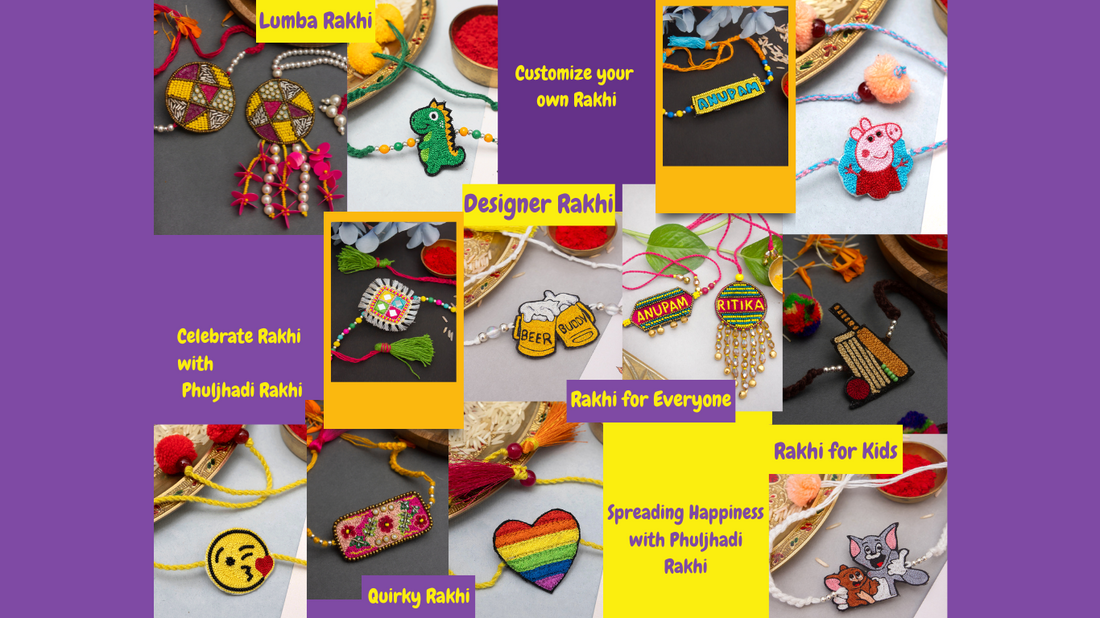
The Charm of Handmade Rakhi: A Tradition of Love and Craftsmanship
Share
Raksha Bandhan, a cherished Indian festival, celebrates the enduring bond between brothers and sisters. The central ritual of this festival involves a sister tying a rakhi, a sacred thread, around her brother’s wrist, symbolizing her love, prayers for his well-being, and his vow to protect her. While commercially manufactured rakhis are abundant, handmade rakhis hold a special place due to their uniqueness, personal touch, and the artistry involved in their creation.
The Essence of Handmade Rakhis
Handmade rakhis embody the essence of love, creativity, and tradition. Each handmade rakhi is a piece of art, meticulously crafted to reflect the unique bond shared between siblings. The time, effort, and thought put into creating a handmade rakhi make it more than just an ornament; it becomes a token of affection and a keepsake that carries sentimental value.
Historical Significance and Evolution
The tradition of tying rakhis dates back centuries, with historical references found in Indian mythology and history. Rani Karnavati’s rakhi sent to Emperor Humayun and Draupadi’s protection sought from Krishna through a rakhi are legendary examples. Originally, rakhis were simple threads with minimal embellishments, but over time, they have evolved into intricate designs made from a variety of materials.
Materials and Techniques
The beauty of handmade rakhis lies in the diverse materials and techniques used in their creation. Artisans and crafters experiment with a range of materials such as silk threads, cotton, beads, sequins, stones, and even precious metals. Techniques like embroidery, weaving, crochet, and beadwork are commonly employed to create exquisite designs.
Silk and Cotton Threads
Silk and cotton threads are the most traditional and widely used materials for handmade rakhis. These threads are often dyed in vibrant colors and intricately woven or braided to form the base of the rakhi. The softness and durability of these threads make them ideal for crafting beautiful and comfortable rakhis.
Beads and Sequins
Beads and sequins add a touch of sparkle and elegance to handmade rakhis. They are used to create intricate patterns and designs, enhancing the overall appeal of the rakhi. Artisans often use glass, wooden, or metallic beads, stringing them together to form elaborate motifs.
Stones and Crystals
Stones and crystals bring a luxurious and glamorous element to handmade rakhis. Semi-precious stones like turquoise, amethyst, and garnet are popular choices. These stones are carefully selected and set into the rakhi, adding a touch of sophistication and making it a precious keepsake.
Embroidery and Crochet
Embroidery and crochet techniques are used to add intricate details and textures to handmade rakhis. Embroidered motifs, floral patterns, and traditional designs are painstakingly crafted using fine threads, showcasing the artisan’s skill and creativity. Crochet rakhis, made using delicate crochet hooks and threads, have a charming and vintage appeal.
Regional Variations
Handmade rakhis reflect the rich cultural diversity of India, with each region adding its unique touch to the craft. The designs, materials, and techniques used in making rakhis vary across different states, reflecting local traditions and aesthetics.
Rajasthan
Rajasthan, known for its vibrant culture and traditional crafts, produces some of the most exquisite handmade rakhis. Rakhis from this region often feature intricate mirror work, colorful threads, and traditional motifs like peacocks and elephants. The use of zari (gold thread) and gota patti (decorative lace) adds a royal touch to Rajasthani rakhis.
Gujarat
In Gujarat, handmade rakhis are characterized by their bright colors and elaborate beadwork. The artisans use vibrant threads and intricate bead patterns to create eye-catching designs. The use of traditional techniques like Bandhani (tie-dye) and mirror work is also prevalent in Gujarati rakhis.
Contemporary Trends
While traditional designs continue to be popular, contemporary handmade rakhis are also gaining popularity. Modern rakhis often incorporate trendy elements, fusion designs, and personalized touches, catering to the tastes of the younger generation.
Eco-friendly Rakhis
With a growing emphasis on sustainability, eco-friendly handmade rakhis have become a trend. These rakhis are made using natural and biodegradable materials like organic cotton, jute, and seeds. Seed rakhis, for instance, contain plantable seeds that can grow into plants, symbolizing growth and renewal.
Personalized Rakhis
Personalized rakhis add a unique and intimate touch to the festival. These rakhis can be customized with names, initials, or special messages, making them a cherished keepsake. Artisans often use techniques like hand-painting, engraving, or digital printing to create personalized designs.
Themed Rakhis
Themed rakhis are another contemporary trend, reflecting popular culture, hobbies, and interests. Superhero-themed rakhis, cartoon character rakhis, and rakhis featuring favorite sports teams or hobbies are popular among children and teenagers.
Conclusion
Handmade rakhis are a beautiful blend of tradition, creativity, and personal touch. They celebrate the bond between siblings in a unique and meaningful way, making the festival of Raksha Bandhan even more special. The artistry, diversity, and innovation involved in creating handmade rakhis ensure that this timeless tradition continues to thrive and evolve, bridging the past and the present while adding new dimensions to the celebration of love and protection.




